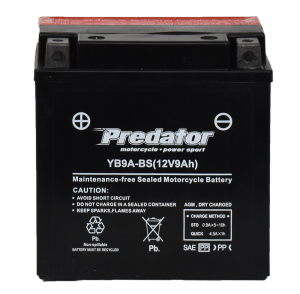Battery 101: Motorcycle Battery Guide
Motorcycles, with their thrilling rides and a sense of freedom are more than just vehicles - they're a lifestyle. Behind every exhilarating journey is a vital component that powers the adventure – the motorcycle battery. In this comprehensive guide, we'll delve into the world of motorcycle batteries, covering everything from battery types and maintenance to essential tips for getting the most out of your battery.
Motorcycle batteries aren't a one-size-fits-all situation. There are various battery technologies, sizes and features that will suit some users and their bikes better than others.

Types of Motorcycle Batteries
Flooded Lead Acid Batteries
Flooded lead acid batteries, also known as conventional batteries are a type of rechargeable battery which has been in use for well over a century. These batteries are widely used in various applications from automotive vehicles to uninterruptible power supplies (UPS) and even energy storage. In this article, we will explore the basics of conventional flooded batteries and their advantages and disadvantages.
Advantages of Flooded Batteries::
- Reliability: Conventional flooded lead acid batteries have a long track record of reliable performance. They are well understood and widely used.
- Low Cost: Flooded lead acid batteries are more affordable compared to some newer battery technologies, making them the most cost effective choice for motorcycles.
- Maintenance Free: Under normal usage these batteries do not require topping up.
- Recyclable: More than 95% of a lead acid battery can be recycled, making it one of the most recyclable man made products on the planet!
Disadvantages of Flooded Batteries::
- Gassing: They can release potentially harmful gases, so they should be used in well ventilated areas.
- Self Discharge: Flooded batteries discharge at a higher rate compared to newer battery technologies like AGM or lithium.
- Sulphation: Lead acid batteries are prone to sulphation, which reduces a battery’s service life. The rate of sulphation increases as a battery discharges, which is why it is best to use a trickle charger if the battery is not being used for extended periods.
- Useable Capacity: Lead acid batteries have a useable capacity of 50%. Discharging a lead acid battery below this will reduce its service life.
AGM Batteries
Absorbent Glass Mat (AGM) batteries are a different type of lead acid battery. They have become popular in various applications due to their durable design and numerous advantages. AGM batteries are the best solution when high performance and an extended service life is required.

Advantages of AGM Batteries:
- Maintenance Free: AGM batteries do not require any maintenance.
- Vibration Resistant: An AGM’s compressed glass mat design means that they are highly resistant to vibration. This is especially important for off road vehicles.
- Spill proof: The electrolyte in an AGM battery is absorbed into the glass mats which are used to separate the plates. This makes AGM batteries spill proof and allows them to be installed in most orientations without the risk of leakage.
- Extended Service Life: AGM batteries can last 2 to 3 times as long as a flooded lead acid battery in the same application.
- Lower Internal Resistance: AGM batteries have a lower internal resistance compared to flooded lead acid batteries. This means they can deliver more starting power and also recharge at a faster rate.
- Lower Self Discharge: AGM batteries have a lower self discharge rate compared to flooded batteries, allowing them to hold their charge for longer periods when not in use.
Disadvantages of AGM Batteries:
- Cost: AGM batteries are more expensive than conventional flooded batteries as they are more complex to manufacture.
- Heat: AGM batteries cannot manage heat as efficiently as flooded batteries and can struggle in high heat applications. A heatshield can help in these situations.
- Useable Capacity: Like other lead acid batteries, AGM batteries have a useable capacity of 50%.
Overall, AGM batteries are a reliable and high performance choice for Motorcycle and Powersport applications. They are an excellent upgrade when looking for a high performance, value for money option over a conventional flooded lead acid battery. Their high vibration resistance makes them an excellent choice for trail bikes and other off road veihcles.
Lithium Iron Phosphate (LiFePO4) batteries
Lithium batteries have become an integral part of our daily lives, revolutionizing the way we use portable electronics, electric vehicles, and renewable energy systems. There are many different types of lithium battery. In this article we will explore how Lithium Iron Phosphate (LiFePO4) batteries can work in your motorcycle and powersport applications.

Advantages of LiFePO4 batteries:
- High Energy Density: LiFePO4 batteries have 3 to 5 times the energy density of lead acid batteries which means they are significantly lighter when compared to a lead acid battery.
- Low Self-Discharge: LiFePO4 batteries have a very low self-discharge rate which means they can be stored for extended periods when not in use.
- Useable Capacity: A LiFePO4 battery has a useable capacity of 100%.
- High Cycle Life: LiFePO4 batteries can deliver thousands of charge and discharge cycles, which helps make them cost effective over their lifespan.
- Fast Charging: LiFePO4 batteries can accept high charge currents, enabling rapid charging.
- Lightweight: They are lightweight thanks to their high energy density, which can help lower the centre of gravity of a motorcycle and improve overall performance.
- Thermal Stability: Some types of lithium battery are susceptible to thermal runaway which can result in fire however this does not apply to LiFePO4 LiFePO4 batteries are thermally stable and use a non-flammable electrolyte. This makes them a safe option.
- Environmental: Unlike many lithium battery types, LiFePO4 batteries are non-toxic and do not contain any rare earth metals.
Disadvantages of LiFePO4 batteries:
- Cost: Lithium batteries are very expensive. They will cost 2 to 4 times the price of a quality lead acid battery however their high initial purchase price is offset by their high performance and extended service life.
- Temperature Range: Although LiFePO4 batteries have a wide operating temperature range (-20°C to 60°C), their performance and charging capability is significantly reduced when the battery is below 0°C. The ideal operating temperature range is between 0°C and 45°C.

Understanding Battery Specifications on the Label:
Cold Cranking Amps (CCA): Used for lead acid batteries, and measures the battery's starting power at -18°C.
Cranking Amps (CA): Also known as Marine Cranking Amps (MCA), measures the battery's starting power at 0°C.
Ampere Hour (Ah): A measure of the battery's energy storage capacity.
Nurturing Your Motorcycle Battery
- Inspection and Cleaning: Regular battery checks prevent surprises. Look for corrosion, loose connections, and signs of damage. Corrosion can be neutralised using a mixture of baking soda and water.
- Charging Wisdom: Proper charging habits extend battery life.
- For lead acid batteries, invest in a smart battery charger to keep your lead acid battery at an optimal State of Charge.
- For lithium batteries, trickle charging a LiFePO4 battery can shorten its service life. Once the battery is charged the battery charger should be disconnected.
- Storing Your Battery: During the off season, disconnect the battery and store it in a cool, dry place. Ensure it is charged before storage to prevent deterioration.
Maximising Motorcycle Battery Life
Mindful Riding Practices: How you ride affects your battery's life. Avoid frequent short trips, as they may not allow the battery to recharge fully.
Taming Electrical Accessories: While accessories can enhance your ride, they can discharge the battery by using power when the ignition is switched off. Make sure that accessories are connected to switched power to protect the battery.
Regular Charging: If your bike sits idle for extended periods, connect a charger every 3 months to top up the battery. If you have a lead acid battery installed, you can also leave it connected to a smart charger to maximise battery life.
Troubleshooting Common Battery Issues
Dealing with a Dead Battery - If your bike won't start, a dead battery might be the culprit. Jump start it using a portable jump pack. Repeated flat batteries may indicate a failed battery or accessories which continue to be powered when the ignition is off.
Slow Cranking - Slow engine cranks can indicate a weak battery or poor quality connections. Check terminals for corrosion and ensure they are clean and tight. If the problem persists, have the motorcycle’s charging system checked.
Motorcycle batteries play a silent yet critical role in your riding experience. By understanding the battery types, practicing proper maintenance, and being aware of how you use your bike, you can ensure that your motorcycle battery remains a reliable source of power. A well maintained battery not only enhances your journey but also deepens your connection to the road and the thrilling moments that await. So gear up, take care of your battery, and hit the open road with confidence!
Explore our battery selection tailored for passionate enthusiasts! It showcases premium quality conventional and AGM battery technologies, ensuring your rides are not only safer but also hassle free and more powerful. Motobatt, Predator and Deka offer an extensive range of battery sizes to cater for most motorcycles, quad bikes, jet skis, and various recreational applications.



